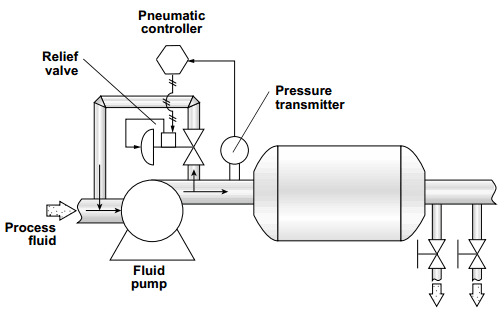This article is about how control components and control algorithms are integrated to create a process control system. Because in some processes many variables must be controlled, and each variable can have an impact on the entire system, control systems must be designed to respond to disturbances at any point in the system and to mitigate the effect of those disturbances throughout the system.
Single Control Loops
Control loops can be divided into two categories: Single variable loops and multi-variable loops.
Feedback Control
A feedback loop measures a process variable and sends the measurement to a controller for comparison to setpoint. If the process variable is not at setpoint, control action is taken to return the process variable to setpoint. Picture 1 illustrates a feedback loop in which a transmitter measures the temperature of a fluid and, if necessary, opens or closes a hot steam valve to adjust the fluid’s temperature.
Picture 1: Feedback Loop
An everyday example of a feedback loop is the cruise control system in an automobile. A setpoint is established for speed. When the car begins to climb a hill, the speed drops below setpoint and the controller adjusts the throttle to return the car’s speed to setpoint. Feedback loops are commonly used in the process control industry. The advantage of a feedback loop is that it directly controls the desired process variable. The disadvantage to feedback loops is that the process variable must leave setpoint for action to be taken.
Examples of Single Control Loops
While each application has its own characteristics, some general statements can be made about pressure, flow, level, and temperature loops.
Pressure Control Loops
Pressure control loops vary in speed—that is, they can respond to changes in load or to control action slowly or quickly. The speed required in a pressure control loop may be dictated by the volume of the process fluid. High-volume systems (e.g., large natural gas storage facilities) tend to change more slowly than low-volume systems (Picture 2).
Picture 2: A Pressure Loop
Flow Control Loops
Generally, flow control loops are regarded as fast loops that respond to changes quickly. Therefore, flow control equipment must have fast sampling and response times. Because flow transmitters tend to be rather sensitive devices, they can produce rapid fluctuations or noise in the control signal. To compensate for noise, many flow transmitters have a damping function that filters out noise. Sometimes, filters are added between the transmitter and the control system. Because the temperature of the process fluid affects its density, temperature measurements are often taken with flow measurements and compensation for temperature is accounted for in the flow calculation. Typically, a flow sensor, a transmitter, a controller, and a valve or pump are used in flow control loops (Picture 3).
Picture 3: A Flow Loop
Level Control Loops
The speed of changes in a level control loop largely depends on the size and shape of the process vessel (e.g., larger vessels take longer to fill than smaller ones) and the flow rate of the input and outflow pipes. Manufacturers may use one of many different measurement technologies to determine level, including radar, ultrasonic, float gauge, and pressure measurement. The final control element in a level control loop is usually a valve on the input and/or outflow connections to the tank (Picture 4). Because it is often critical to avoid tank overflow, redundant level control systems are sometimes employed.
Picture 4: A Level Loop
Temperature Control Loops
Because of the time required to change the temperature of a process fluid, temperature loops tend to be relatively slow. Feedforward control strategies are often used to increase the speed of the temperature loop response. RTDs or thermocouples are typical temperature sensors. Temperature transmitters and controllers are used, although it is not uncommon to see temperature sensors wired directly to the input interface of a controller. The final control element for a temperature loop is usually the fuel valve to a burner or a valve to some kind of heat exchanger. Sometimes, cool process fluid is added to the mix to maintain temperature (Picture 5).
Picture 5: A Temperature Loop





No comments:
Post a Comment